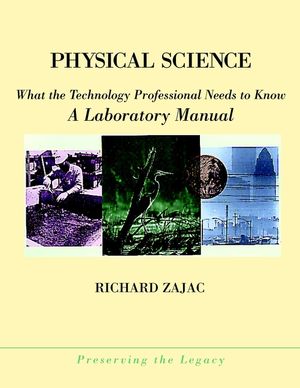Physical Science: What the Technology Professional Needs to Know: A Laboratory ManualISBN: 978-0-471-36019-3
Paperback
440 pages
January 2001
 This is a Print-on-Demand title. It will be printed specifically to fill your order. Please allow an additional 10-15 days delivery time. The book is not returnable.
|
||||||
This laboratory manual is designed to be used with the text, Physical Science: What the Technology Professional Needs to Know. Developed for the aspiring technology professional with little or no background in the study of physics or chemistry, it provides the experience necessary for students to develop skills in experimentation and data interpretation.
Like all of the books in the critically acclaimed Preserving the Legacy series, this manual is easy to understand and use, with clear instructions and a discovery approach. The book contains 26 experiments that have been carefully selected to illustrate major physics and chemistry concepts. They require simple, inexpensive equipment and are designed to be completed within three hours.
Each experiment starts with a review of the background concepts, information, and formulas necessary to carry out the experiment. Three or four investigations are then presented, each with its own objectives, procedures, and interpretation. Next, students are asked to demonstrate their understanding by bringing together selected data and conclusions in the preparation of a "Report Sheet." In a final section, students are given the opportunity to demonstrate their understanding of the concepts by applying them to a new situation.
Topics addressed in the experiments include:
* Measurements
* Matter and energy
* Acids and bases
* Motion
* Electricity
* Optics
* Nuclear processes
* Chemical reactions
Like all of the books in the critically acclaimed Preserving the Legacy series, this manual is easy to understand and use, with clear instructions and a discovery approach. The book contains 26 experiments that have been carefully selected to illustrate major physics and chemistry concepts. They require simple, inexpensive equipment and are designed to be completed within three hours.
Each experiment starts with a review of the background concepts, information, and formulas necessary to carry out the experiment. Three or four investigations are then presented, each with its own objectives, procedures, and interpretation. Next, students are asked to demonstrate their understanding by bringing together selected data and conclusions in the preparation of a "Report Sheet." In a final section, students are given the opportunity to demonstrate their understanding of the concepts by applying them to a new situation.
Topics addressed in the experiments include:
* Measurements
* Matter and energy
* Acids and bases
* Motion
* Electricity
* Optics
* Nuclear processes
* Chemical reactions



